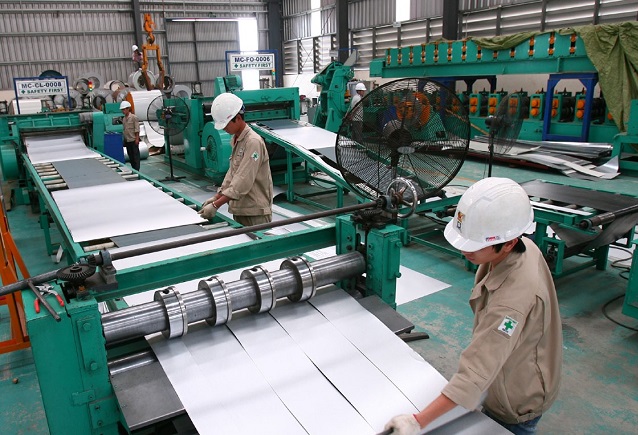Steel market expected to cool until late 2021
A cut of steel prices from Vietnam's major steelmakers will drive up the domestic market in the next months.
Vietnamese businesses are hoping to maintain stable prices of steel products from now on until the end of this year after the market has witnessed a decline in prices in recent weeks.
The cut of still prices announced by the local major steelmakers on June 9 is seen as a poke to push back the stagnancy of the steel market, which had had a price hike since late 2020.
| Steel production at Siam Steel Vietnam. Photo: Hai Linh |
Hoa Phat Group quoted the price of rolled steel model CB240 at VND17.2 million (US$750) per ton, down by nearly VND1 million (US$43) from the peak at VND18.3 million (US$794) recorded one month ago, while the price of steel bar also decreased by VND500,000-700,000 (US$21.7-30.3) per ton.
Prices of rolled steels produced by Viet Duc steel are also cut by VND960,000 (US$42) per ton against early June to VND17 million (US$738).
Vice Chairman of the Vietnam Steel Association (VSA) Do Xuan Chieu said lower steel prices in the domestic market was due to the decline in prices of input materials, including iron ore, steel ingots, which make up 70-80% of the list prices.
Chieu referred to the fact that most-traded September iron ore on China’s Dalian Commodity Exchange ended at the lowest point since June at US$173.03 per ton, while the July contract for iron ore on the Singapore Exchange also declined by 2% to US$173.03.
“A stagnant in steel demand from the Chinese market has led to prices decline,” said Chieu.
In the Vietnamese market, VSA Chairman Nghiem Xuan Da attributed freezing construction activities as in the rainy season in June and July to low demand for steel.
According to Da, the peak season for construction would normally fall in the first and fourth quarters of the year.
“The declines, however, remain modest at around 3-5%, as steel prices are expected to go up as construction activities heat up,” he noted.
A recent report from Fitch Solutions suggested global steel prices would reach US$800 per ton in the final half of this year, an increase of US$140 per ton against its previous forecast, pointing out an imbalance between supply and demand.
Fitch Solutions experts have also said that the decline in steel prices would be insignificant as consumption demand is forecast to go up.
Steel prices are predicted to moderate to around US$600 per ton by 2022, stated Fitch Solutions.
Halt on increasing steel prices
To further halt the steel price hiking, Da from the VSA noted that along with keeping operational costs at an efficient level, local steel producers should prioritize domestic markets as measures to prevent steel prices from surging.
“Policies from the government are needed to temporarily discourage steel exports,” Da said.
At a recent meeting with local steel producers, Minister of Industry and Trade Nguyen Hong Dien stressed the necessity for local firms to focus on iron ore mining and processing, in turn creating stable supplies of input materials for steel production.
“Vietnamese steel producers should pay more attention to the R&D process to better ensure the supply sources and produce higher quality steel products,” he added.
Economist Vu Dinh Anh told The Hanoi Times that as steel prices are driven by the market, construction companies should draft plans to keep a hold on steel supplies to minimize impacts from rising steel prices.
“The government can only intervene when there is a major disruption to the local market,” Anh said.











